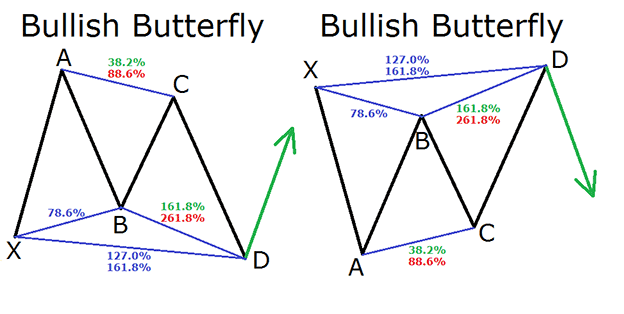Forex trading strategies for using the Harmonic Butterfly pattern: Techniques for trading with the Harmonic Butterfly pattern.
In the vast world of forex trading, where volatility and opportunity collide, traders are constantly in search of effective strategies to navigate the complexities of the market. One such strategy that has gained prominence in recent years is the Harmonic Butterfly pattern. This intricate pattern, when identified and utilized correctly, can offer traders a unique edge in their pursuit of consistent profits. In this article, we will delve into the techniques and strategies for trading with the Harmonic Butterfly pattern, shedding light on its intricacies and potential benefits.
Table Content
I. Understanding the Harmonic Butterfly Pattern
II. Trading Techniques with Harmonic Butterfly Pattern
1. Pattern Recognition
2. Confluence Zones
3. Fibonacci Ratios Confirmation
4. Price Action Analysis
5. Entry and Exit Strategies
6. Risk Management
7. Back testing and Practice
8. Market Conditions Consideration
III. Benefits and Challenges of Trading with Harmonic Butterfly Pattern
IV. Footnote
Understanding the Harmonic Butterfly Pattern
The Harmonic Butterfly pattern is a specialized chart formation that falls under the broader category of harmonic patterns. These patterns are a fusion of Fibonacci ratios and geometric shapes that identify potential reversal zones in the market. The Butterfly pattern is unique due to its symmetry and distinct ratios. It consists of five key points: X, A, B, C, and D. The pattern resembles the wings of a butterfly, with specific ratios guiding the retracement and extension levels.

- X to A Leg: The pattern begins with a significant price move known as the "X to A" leg. This leg represents the initial impulsive move that forms the basis of the pattern.
- A to B Leg: The A to B leg is a retracement of the X to A leg, often in the range of 38.2% to 61.8% Fibonacci retracement.
- B to C Leg: The B to C leg is an extension of the A to B leg, typically around 38.2% Fibonacci extension.
- C Point: The C point is where the B to C leg terminates. It marks a reversal point, usually around 78.6% retracement of the X to A leg.
- D Point: The D point is the critical point of the pattern. It completes the structure and is an extension of the X to A leg. It typically aligns with the 127.2% or 161.8% Fibonacci extension of the X to A leg.
Trading Techniques with Harmonic Butterfly Pattern
Trading with the Harmonic Butterfly pattern requires a combination of technical analysis, pattern recognition, and risk management. Here are some techniques that traders can consider integrating into their trading strategies:
1. Pattern Recognition:
Identifying the Harmonic Butterfly pattern is the foundation of trading with it. Utilizing charting software with pattern recognition capabilities can significantly ease this process. Keep an eye out for symmetry between the X to A and A to D legs, as well as adherence to Fibonacci ratios in each leg.
2. Confluence Zones:
Confluence occurs when multiple technical indicators align in a specific price zone, increasing the pattern's validity. Look for confluence between the D point of the Harmonic Butterfly pattern and other technical tools such as support/resistance levels, trendlines, or moving averages.
3. Fibonacci Ratios Confirmation:
Confirming the pattern's alignment with Fibonacci ratios enhances its reliability. When the D point of the Butterfly pattern aligns with other Fibonacci levels, it reinforces the potential reversal zone.
4. Price Action Analysis:
Incorporate price action analysis to assess market sentiment and potential reactions at the reversal zone. Candlestick patterns, trend continuation or reversal signals, and momentum indicators can provide valuable insights.
5. Entry and Exit Strategies:
Determining entry and exit points is crucial. Traders often enter a trade at the completion of the D point and place a stop loss below the X point or the C point, depending on risk appetite. Profit targets can be set at significant Fibonacci extension levels beyond the D point.
6. Risk Management:
Effective risk management is paramount. Never risk more than a predetermined percentage of your trading capital on a single trade. Utilizing proper position sizing and stop-loss orders can safeguard your account from substantial losses.
7. Back testing and Practice:
Before implementing the strategy in a live trading environment, conduct thorough back testing. This involves applying the strategy to historical price data to assess its effectiveness. Practice in a demo account to gain familiarity with the strategy's nuances and refine your execution.
8. Market Conditions Consideration:
Understand that no strategy works optimally in all market conditions. The Harmonic Butterfly pattern might perform differently in ranging, trending, or volatile markets. Adapt your approach based on the prevailing conditions.
Benefits and Challenges of Trading with Harmonic Butterfly Pattern
Benefits:
- Precision: The Harmonic Butterfly pattern offers a specific framework for identifying potential reversal zones, enhancing trading precision.
- Risk-Reward Ratio: The pattern's predefined entry, stop-loss, and take-profit levels allow traders to maintain a favorable risk-reward ratio.
- Objective Trading: Trading based on a well-defined pattern removes emotional biases, leading to more objective decision-making.
- Confluence Opportunities: The pattern often aligns with other technical tools, providing confluence zones that reinforce trading decisions.
Challenges:
- Pattern Subjectivity: Identifying the pattern accurately requires practice and a keen eye, as slight variations can lead to different patterns.
- False Signals: Like any trading strategy, false signals can occur. Not every Harmonic Butterfly pattern will lead to a successful trade.
- Complexity: The intricate nature of harmonic patterns can be overwhelming for novice traders, necessitating a comprehensive understanding.
- Market Risk: No strategy is immune to market risks. Sudden economic events or geopolitical factors can disrupt pattern-based trades.
Footnote:
The Harmonic Butterfly pattern is a powerful tool in a trader's arsenal, offering a structured approach to identifying potential reversal zones in the forex market. However, mastering this pattern requires dedication, practice, and continuous learning. Traders should combine the pattern's technical aspects with sound risk management and adaptability to changing market conditions. While the Harmonic Butterfly pattern can enhance trading precision, it's crucial to acknowledge its limitations and the inherent risks of forex trading. As with any trading strategy, discipline and patience remain the cornerstones of success.











Discussion